RBI Predicts Private Capex FY26 to Rise 21.5% to ₹2.67 Lakh Cr

India’s private sector is gearing up for a major investment boost in the Financial Year 26. According to an RBI article, private capex is expected to rise 21.5% to ₹2.67 lakh crore. It is all because of stronger balance sheets, higher profitability, and access to diversified funding sources.
The RBI notes that lower interest rates, easy liquidity, and rising capacity utilisation are creating the right environment for businesses to expand. Much of this growth will be led by the infrastructure sector, with power and construction projects at the forefront.
While global uncertainties and geopolitical tensions may pose challenges, the ability of firms to execute their capital investment plans will be crucial.
Key Highlights of Private Capex Outlook (FY26)
- Private Capex FY26 is expected to rise 21.5% to ₹2.67 lakh crore, up from ₹2.20 lakh crore in FY25.
- Lower interest rates (a 1% policy rate cut), stronger company finances, and factories running closer to full capacity are encouraging businesses to invest more.
- The infrastructure sector continues to attract the largest share of investment, led by power and construction projects.
- Firms have access to multiple financing sources for diversified funding: bank loans, equity issuance, and external borrowings.
- Greenfield infrastructure projects and higher capex intentions point to both cyclical recovery and long-term capacity building.
- Geopolitical tensions, demand slowdown, and external uncertainty remain key challenges.
How Rising Private Capex Shapes Growth
The21.5% rise in private capex signals fresh momentum for India’s economy. For markets, it is a positive sentiment for capital goods, infrastructure, and construction stocks. Companies supplying machinery, cement, and steel are likely to benefit the most.
Let’s look at how sectors impact:
- Infrastructure Sector: It continues to dominate investment, with power projects taking the lead.
- Capital Goods: Rising capital expenditures (capex) mean increased demand for machinery and equipment, which in turn lifts the capital goods index.
- Construction & Materials: Cement, steel, and allied industries are likely to see higher orders as new projects are rolled out.
- Financials: Banks and NBFCs could benefit as demand for corporate loans and funding grows.
Final Thought
External risks, such as US tariffs and a global slowdown, could still create volatility. Traders should keep stop-loss tight and watch sector rotation. If businesses turn investment plans into execution, India’s growth momentum can become more broad-based and durable. Thus, investors must focus on quality companies with strong balance sheets and proven execution capabilities.
Source: MoneyControl
Disclaimer: Investments in the securities market are subject to market risks; read all the related documents carefully before investing.








